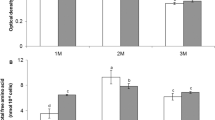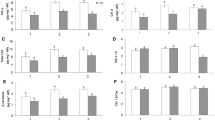Abstract
The osmoregulatory mechanisms of chemolithotrophs have not previously been investigated. We tested glutamic acid, proline, and betaine as potential osmorprotectants for the acidic chemolithotrophThiobacillus ferrooxidans. Salt stresses were imposed by NaCl, KCl, Na2SO4, and K2SO4 in separate experiments. Proline enhanced rates of iron oxidation in all saltstressed cultures, whereas betaine acted as an osmoprotectant only in sulfate-salt-stressed cultures and in cultures severely stressed by NaCl (0.3–0.4M). Glutamic acid inhibited iron oxidation in all cases.
Similar content being viewed by others
Literature Cited
Bernard T, Pocard JA, Perroud B, Le Rudulier D (1986) Variations in the response of salt-stressedRhizobium strains to betaines. Arch Microbiol 143:359–364
Botsford JL (1984) Osmoregulation inRhizobium meliloti: inhibition of growth by salts. Arch Microbiol 137:124–127
Brierley CL (1978) Bacterial leaching. Crit Rev Microbiol 5:207–262
Brock TD (1975) Effect of water potential on growth and iron oxidation byThiobacillus ferrooxidans. Appl Microbiol 29:495–501
Cameron FJ, Jones MV, Edwards C (1984) Effects of salinity on bacterial iron oxidation. Curr Microbiol 10:353–356
Cote R (1984) ATCC Media Handbook. Rockville, Maryland: American Type Culture Collection
Galinsky EA, Trüper HG (1982) Betaine, a compatible solute in the extreme halophilic phototrophic bacteriumEctothiorhodospira halochloris. FEMS Lett 13:357–360
Greenberg AE, Trussell RR, Clesceri LS (1985) Standard methods for the examination of water and wastewater, 16th edn. Washington, DC: American Public Health Association
Harris RF (1981) Effect of water potential on microbial growth and activity. In: Parr JF, Garner WR, Elliott WF (eds) Water potential relations in soil microbiology. Madison, Wisconsin: Soil Science Society of America, pp 23–95
Harrison AP (1984) The acidophilic thiobacilli and other acidophilic bacteria that share their habitat. Annu Rev Microbiol 38:265–292
Ingledew WJ (1982)Thiobacillus ferrooxidans: the bioenergetics of an acidophilic chemolithotroph. Biochim Biophys Acta 683:89–117
Killham K, Firestone MK (1984) Salt stress control of intracellular solutes in streptomycetes indigenous to saline soils. Appl Env Microbiol 47:310–306
Killham K, Firestone MK (1984) Proline transport increases growth efficiency in salt-stressedStreptomyces griseus. Appl Env Microbiol 48:239–241
Le Rudulier D, Bouillard L (1983) Glycine betaine, an osmotic effector inKlebsiella pneumoniae and other members of the Enterobacteriaceae. Appl Env Microbiol 46:152–159
Le Rudulier D, Strom AR, Dandekar AM, Smith LT, Valentine RC (1984) Molecular biology of osmoregulation. Science 224:1064–1068
Mackay MA, Norton RS, Borowitzka LJ (1983) Marine bluegreen algae have a unique osmoregulatory system. Mar Biol 73:301–307
Mackay MA, Norton RS, Borowitzka LJ (1984) Organic osmoregulatory solutes in cyanobacteria. J Gen Microbiol 130:2177–2191
Measures JC (1975) Role of amino acids in osmoregulation of non-halophilic bacteria. Nature 257:398–400
Olson GJ, McFeters GA, Temple KL (1981) Occurrence and activity of iron- and sulfur-oxidizing microorganisms in alkaline coal strip mine spoils. Mirob Ecol 7:39–50
Reed RH, Richardson DL, Warr SRC, Stewart WDP (1984) Carbohydrate accumulation and osmotic stress in cyanobacteria. J Gen Microbiol 130:1–4
Tuttle JH, Dugan PR (1976) Inhibition of growth, iron and sulfur oxidation inThiobacillus ferrooxidans by simple organic compounds. J. Microbiol 22:719–730
Warr SRC, Reed RH, Steward WDP (1984) Osmotic adjustment of cyanobacteria: the effects of NaCl, KCl, sucrose and glycine betaine on glutamine synthetase activity in a marine and a halotolerant strain. J Gen Microbiol 130:2169–2175
Author information
Authors and Affiliations
Rights and permissions
About this article
Cite this article
Kieft, T.L., Spence, S.D. Osmoregulation inThiobacillus ferrooxidans: Stimulation of iron oxidation by proline and betaine under salt stress. Current Microbiology 17, 255–258 (1988). https://doi.org/10.1007/BF01571324
Issue Date:
DOI: https://doi.org/10.1007/BF01571324




